
What happens when the core promises of a crypto-currency no longer hold true? Frances Coppola, a Senior Contributor at Forbes explains that Tether, a so-called “stablecoin,” that is supposedly pegged to the U.S. dollar may not be as linked to the fiat currency as has been advertised. She writes:
USDT is the foremost stablecoin in the crypto world. Pegged one for one to the U.S. dollar, it is widely used as a vehicle for getting dollars in and out of crypto exchanges. Crypto enthusiasts will tell you that holding USDT (“Tethers”) is the same as holding dollars. But now, Tether, the issuer of USDT, has now admitted that Tethers are not 100% backed by actual dollars. The peg is no longer credible. And Tether itself has morphed into something all too familiar.
She goes on to explain how Tether’s wording of its dollar peg has changed, and then writes:
So Tether does not have 100% traditional currency backing for its reserves. It has “cash equivalents,” which are presumably other cryptocurrencies (like pegging to a volatile asset is such a good way of ensuring stability). And some of its “reserves” are held in the form of loans that it has made to other parties. Tether has become an unregulated fractional reserve bank.
It’s a very risky fractional reserve bank, too. Loans that you can’t sell, can’t pledge for cash, and may or may not be able to call are not by any stretch of the imagination “reserves.” No regulator would let a licensed bank get away with this, even though licensed banks have Fed backing and FDIC insurance. Tether may regard one USDT as the same as one U.S. dollar, but without either the reserves or the central bank backing to guarantee this, its words are empty. The Fed isn’t going to step in and bail it out.
Read more from Coppola here.
There appears to be little possible recourse for Tether users if things go south for the crypto-currency. Speculators betting on crypto-currencies like Tether should be paying very close attention. A loss of faith in Tether and other crypto-currencies could free up the massive computer power that has been setup to “mine” them, making way for what futurist George Gilder calls the “Cryptocosm,” and a powerful competitor to Google and other massive tech companies.
Originally posted on Your Survival Guy.



